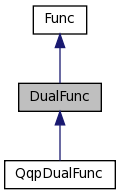DualFunc Class Reference
A abstract base class for a dual function of a MinlpReform. More...
#include <dualqqp.h>
Inheritance diagram for DualFunc:

Collaboration diagram for DualFunc:

Public Member Functions | |
| DualFunc (MinlpProblem &qqp_, Param ¶m_, Pointer< ostream > out_func_p_=out_out_p, Pointer< ostream > out_func_log_p_=out_log_p) | |
| Constructor for a MinlpReform. | |
| int | primal_dim () const |
| The dimension of the MINLP-problem, not the dual one. | |
| virtual dvector | get_dual_point () const =0 |
| Gives the last dual point. | |
| virtual double | get_dual_val () const =0 |
| Gives the last dual value. | |
| virtual dvector | get_orig_point (int i=0) const =0 |
| Gives the last solution point of the original problem. | |
| virtual int | nr_of_orig_points () const |
| The number of points, you can get with get_orig_point(). | |
| virtual void | set_curvature (CurvatureType ct) |
| virtual CurvatureType | get_curvature () const |
Public Attributes | |
| MinlpProblem & | qqp |
| The MINLP problem. | |
| vector< double > | dual_bounds |
| The lower bounds of the dual variables. | |
| Param & | param |
| The parameters of the Minlp-solver. | |
Detailed Description
A abstract base class for a dual function of a MinlpReform.
The dimension should be the one form the dual problem. You can get the dimension of the primal problem with primal_dim().
In addition to the methods from Func, you need to implement:
- dvector get_dual_point() to get the last dual point
- double get_dual_val() to get the last dual value
- dvector get_orig_point() to get the last point from the original problem
Definition at line 25 of file dualqqp.h.
Constructor & Destructor Documentation
| DualFunc::DualFunc | ( | MinlpProblem & | qqp_, | |
| Param & | param_, | |||
| Pointer< ostream > | out_func_p_ = out_out_p, |
|||
| Pointer< ostream > | out_func_log_p_ = out_log_p | |||
| ) | [inline] |
Constructor for a MinlpReform.
The dual dimension is set to 0 at this moment and should be set by a derived class.
Member Function Documentation
| int DualFunc::primal_dim | ( | ) | const [inline] |
| virtual dvector DualFunc::get_dual_point | ( | ) | const [pure virtual] |
Gives the last dual point.
- Returns:
- The last dual point, which was used to evaluate this function.
Implemented in QqpDualFunc.
| virtual double DualFunc::get_dual_val | ( | ) | const [pure virtual] |
Gives the last dual value.
- Returns:
- The last dual value, which was calculated with this function.
Implemented in QqpDualFunc.
| virtual dvector DualFunc::get_orig_point | ( | int | i = 0 |
) | const [pure virtual] |
Gives the last solution point of the original problem.
In some dual functions, you can get more than one point.
- Parameters:
-
i The number of this point to get. 0 should give you the best one.
- Returns:
- The last solution point of the given problem.
- See also:
- get_orig_point(int)
Implemented in QqpDualFunc.
| virtual int DualFunc::nr_of_orig_points | ( | ) | const [inline, virtual] |
| virtual void DualFunc::set_curvature | ( | CurvatureType | ct | ) | [inline, virtual] |
| virtual CurvatureType DualFunc::get_curvature | ( | ) | const [inline, virtual] |
Member Data Documentation
| vector<double> DualFunc::dual_bounds |
The documentation for this class was generated from the following file:
 1.6.1
1.6.1